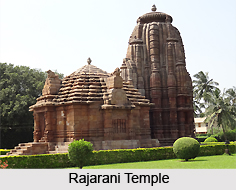 Dating back to the eleventh century, the Rajarani temple is positioned in open paddy fields, and the complete structure exudes refinement and sophistication. The name of the temple has been the subject of debate. The most likely elucidation is that the name is related to the attractive red-and- gold sandstone used in its edifice, a stone which is known locally as rajarani. The debate is complicated by the fact that the names of all the Hindu temples in Bhubaneswar dedicated to the God Shiva end in the suffix eswar (for example Parasurameswara, Mukteswara, etc.), while those of the non-Shaivite temples are derived from their presiding deities (e.g. Parvati temple). One scholar has argued that the name Rajarani was only applied to the temple at a later date (because of the sandstone), and that originally this is the Shiva shrine referred to in early texts as Indreswara.
Dating back to the eleventh century, the Rajarani temple is positioned in open paddy fields, and the complete structure exudes refinement and sophistication. The name of the temple has been the subject of debate. The most likely elucidation is that the name is related to the attractive red-and- gold sandstone used in its edifice, a stone which is known locally as rajarani. The debate is complicated by the fact that the names of all the Hindu temples in Bhubaneswar dedicated to the God Shiva end in the suffix eswar (for example Parasurameswara, Mukteswara, etc.), while those of the non-Shaivite temples are derived from their presiding deities (e.g. Parvati temple). One scholar has argued that the name Rajarani was only applied to the temple at a later date (because of the sandstone), and that originally this is the Shiva shrine referred to in early texts as Indreswara.
Architecture:
The jagmohana (porch) is enormously plain, and was evidently repaired in 1903 after having fallen down in ruins. The deul (tower), on the other hand, is spectacularly elaborate, and is celebrated for the aesthetic concept of miniature temple spires clustered around the main tower. The sculptural images of the temple are elegant and lively, especially the beautiful female figures which can be seen in amorous dalliance, as well as engaged in such activities as holding children, looking in mirrors, and playing with pet birds. On the lower register of the deul, on the corner projections, are found the famous `Guardians of the Eight Directions`, watching over (and radiating the temple`s power to) the eight cardinal points. Beginning from the left of the entrance to the deul and proceeding in a clockwise direction, they are: Indra (east, chief of the 33 Vedic nature deities); Agni (south-east, Vedic God of fire); Yama (south, God of death); Nirriti (south-west, deity related to suffering); Varuna (west, a Vedic deity of the ocean); Vayu (north-west, wind God); Kubera (north, lord of wealth, shown here with a wish-fulfilling tree); and Ishana (north-east, a form of Shiva).
Festivals:
Rajarani Music Festival conducted against the backdrop of the 11th century Rajarani Temple in Bhubaneswar is an evening of concerts. It is soothing, entertaining and inspirational. The city comprises of a massive throng of celebrated temples of which the Rajarani Temple is one of the most conspicuous.
The musical evenings are magnificent with exceptional performances by the great maestros of Indian classical music creating a metaphor of darbari gayans (musical performances in an Indian king`s court) of age-old histories.
At present, as the capital of an emergent Orissa, Bhubaneswar is a modern city with broad avenues, beautiful parks, attractive shopping centres, excellent hotels and restaurants with finger-licking food.
Orissa vis-a-vis India has a great tradition of classical music, instrumental as well as vocal, which fascinate a lot of domestic and international tourists.











